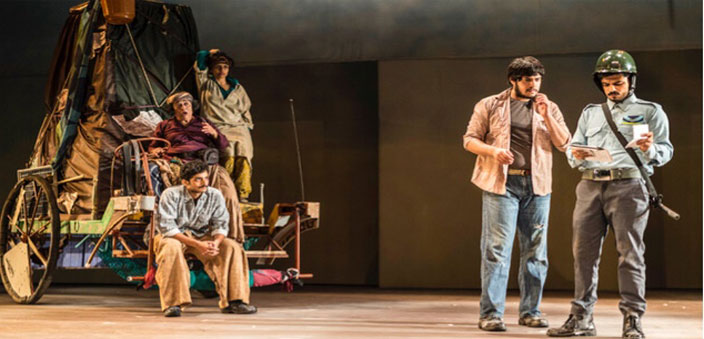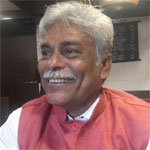Bertolt Brecht (1898-1956), an important playwright of the 20th century, has been performed regularly of late on Mumbai’s theatre scene. Even the ‘Aadyam’, an Aditya Birla initiative to support good theatre, found it meaningful to back the production of Brecht’s Mother Courage and her children, directed by Quasar Thakore Padamsee. Quasar took the English version of Eric Bentley and indianised it. This play was staged recently at the NCPA’s Homi Bhabha theatre.
Who was Bertold Brecht?
Brecht was a left-leaning playwright who could not breathe freely in Hitler’s Germany, and left it in February 1933 to migrate first to Prague, then on to Denmark, and finally to USA in May 1941, where he stayed till 1949. He expressed his opposition to Fascism and Nazism through his plays like The Life of Galileo, Mother Courage and her children, The Caucasian Chalk circle and Fear and Misery of the Third Reich.
While in USA, he was suspected of pro-Left sympathies and had to appear before the infamous HUAC (House Un-American Activities Committee) headed by Senator Joseph McCarthy. Brecht was hounded for quite some time and came back to East Germany in 1949, which then was under Soviet Union. Initially, like all left-leaning writers and intellectuals, he had high hopes from the Red government, but soon felt disappointed, especially after the East German government ruthlessly put down the uprising in June 1953. His famous poem Solution captures his viewpoint about the Left government in East Germany. In this poem, he said:

“After the uprising of 17th of June/ The Secretary of the Writers Union/ Had leaflets distributed in Stalinallee/ Stating that the people/ Had forfeited the confidence of the government/ And could win it back only/By redoubled efforts/ Would it not be easier/In that for the government/To dissolve the people/And elect another?”
The seminal war
The backdrop of Brecht’s Mother Courage and her children is the Thirty Years War (1618-1648) that had rocked entire Europe, and was fought between the Protestants and the Catholics. In the Indian version, this has been replaced by fundamentalists v/s extremists. The play covers a 12-year period in the Thirty Years War and centres around a middle-aged woman with two sons and one daughter. She is wily, cunning and wants to profit from the war. She has been making a living by running a mobile canteen and is travelling with the Protestant army. She is in a hurry to make a bumper profit as the war progresses, but in due course realizes that war is a dirty business as it claims her two sons and she has to helplessly see her daughter raped. This is where the sub-title of the play ‘Everybody loves a good war’ makes sense. In the end, nobody profits from war and common people suffer, as they do even today. This is the timeless message of Brecht’s play. The play also tells the story of hope in times of conflict, of resilience in the face of loss and of survival. In the end, mother is the only person from her family who manages to survive.
The play and its relevance today
The play opens with a large canteen-wagon. It is loaded with Mother Courage’s wares and possessions, pulled by her two sons, Swameed and Alif. They are of mixed parentage. Swameed’s father is a Gujarati while Alif’s is a South Indian. There is a dumb daughter Kamrin. It is an irony of life that Mother Courage loses her children to the very war she expects to profit from. It is a trilingual play in which Hindi, Marathi and Gujarati are liberally used.
Quasar Thakore Padamsee has scored a coup of sorts when he managed to persuade Arundhati Nag, 62, from Bangalore, to play the role of Mother Courage. Arundhati had played this role some thirty-odd years ago in the Kannada adaptation of this play. It is sheer pleasure to see this senior thespian on stage after a long time. She carries the important role of mother effortlessly. Arundhati has an able team to support her in Abhishek Krishnan who plays Alif, the elder son, Junaid Khan who plays Swameed, the second son, and Bhavna Pani, who plays the daughter. Then there are other members of the team, Aseem Hattangady, Asif Ali Beg, Bhushan Vikas and Trupti Khamkar who deliver credible performances. Special mention must be made of lights (Arghya Lahiri) and costumes (Meghana Khanna).
The play is quite timely in this age of war-mongering. However, in terms of pace, the play needs to be tightened a bit. Also, the change of locale from Europe to the Indian sub-continent reduces the impact of the play; the original is quite focused in its intention and the history of religious wars in Europe makes the original a gripping piece of art, whereas the Indian adaptation loses in impact as the fight between the fundamentalists and extremists does not engage the audience as much. And yet, this play is worth a watch.


 [/column]
[/column]